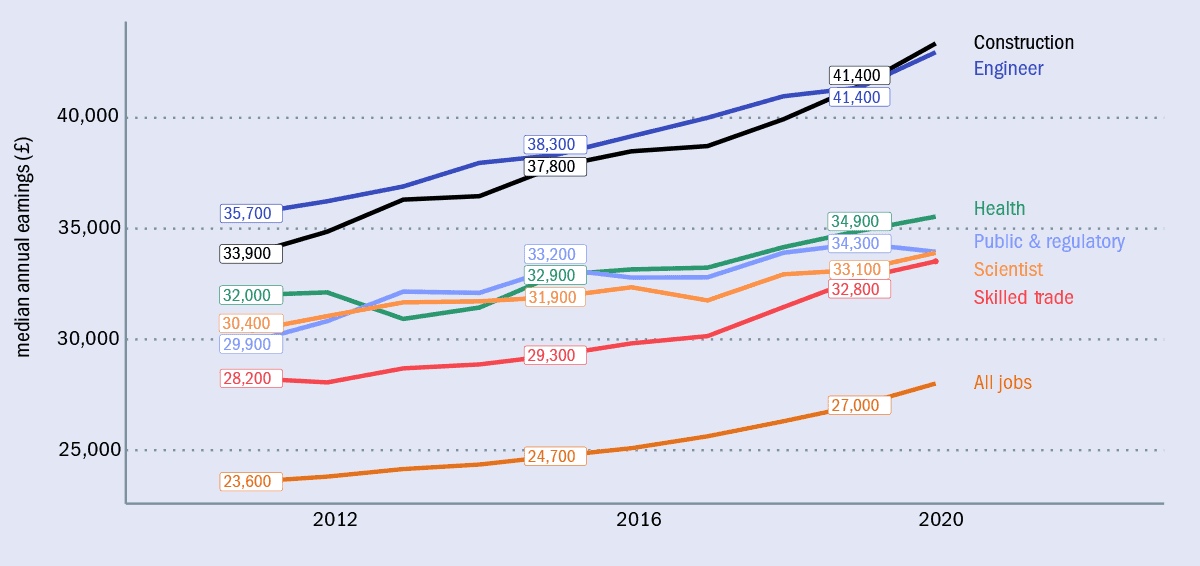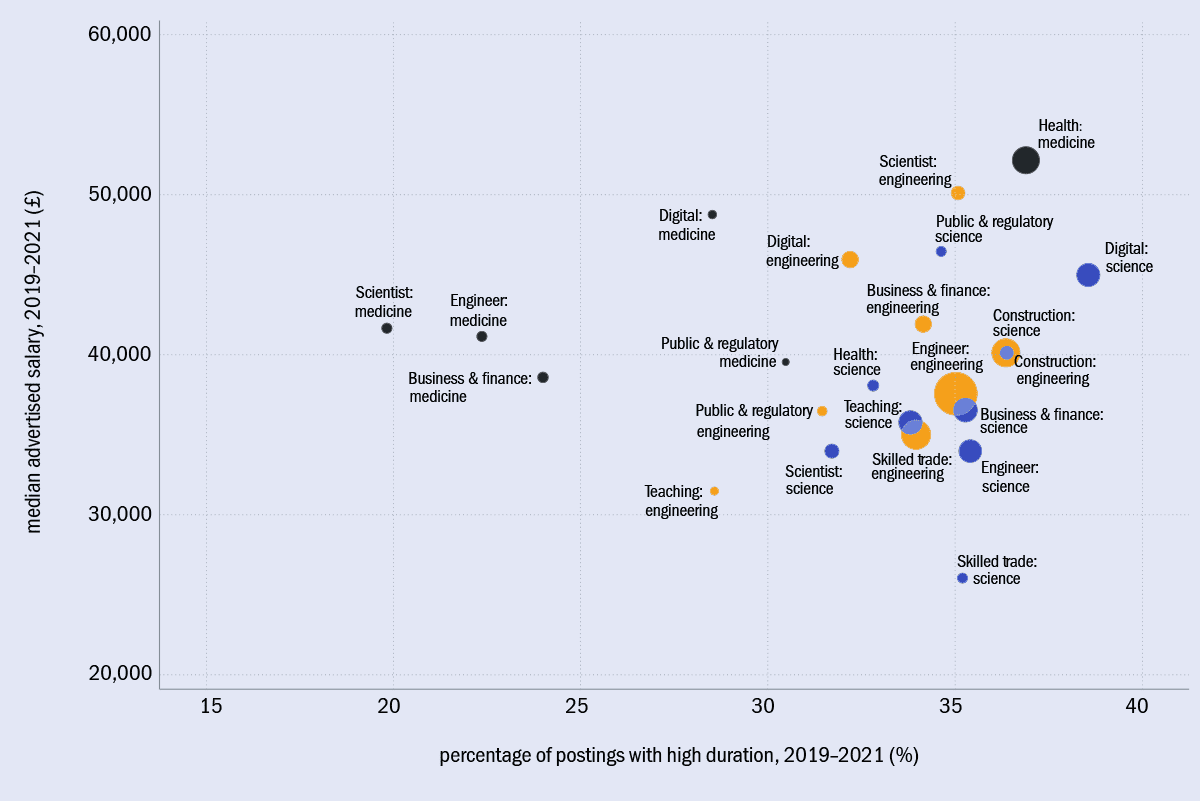The growth of physics-based roles in sectors such as green energy and data science is fuelling the need for employees with physics expertise. Sharon Ann Holgate explores the findings of a recent report from the Institute of Physics into the labour market for physics skills in the UK and Ireland

If you are an early-career physicist, or about to graduate with a degree in physics, then I have some good news for you. There is a substantial and growing need for employees with physics skills and knowledge in the UK and Ireland. But as well as requiring physics expertise, most roles generally call for additional transferable skills that will enable candidates to successfully apply physics within the workplace.
Additionally, employers value physics know-how not only in its own right, but also as a foundation for solving complex problems in areas outside science. These are some of the main findings of a 2022 report Physics in Demand: the Labour Market for Physics Skills in the UK and Ireland produced for the Institute of Physics (IOP) by labour-market analytics specialists Emsi Burning Glass.
Increasing opportunities
By combining market research, analysis and data expertise, the Physics in Demand report finds that one in 20 jobs requires physics skills – quantitatively speaking, that is 1.85 million jobs in 2020 across the UK and Ireland – with demand increasing over the decade between 2010 and 2020. The fastest-growing are roles as scientists, which are up 24% since 2010, with demand for physical scientists within that group rising by 40%. The slowest-growing are teaching positions, which only exhibited 6% growth over the same period. In terms of adding the highest volume of jobs during that decade, construction managers came out on top with 28,100 net new jobs and showing 21% growth.
The report also highlights an increasing need for physics skills and knowledge in roles not traditionally associated with the field. Physics expertise is required in many sectors, including healthcare, the public and regulatory sector, teaching, engineering, construction and manufacturing. Within higher-skilled jobs, increasing opportunities are opening up in data science, software engineering, computer science and quantitative analysis. Demand is also increasing for physics skills in the business, financial and digital sectors. As the report puts it: “The analytical rigour associated with physics gives physics-trained professionals competitive advantages in taking on these roles, distilling their complex problems and identifying how to solve them.”

Green jobs for physics graduates: opportunities to help build a sustainable future
One of the biggest scientific challenges for the immediate future is within the global energy sector, with the push towards net-zero emissions. As the report stresses, physics is fundamental to that quest, and will likely hold the solutions for many of the questions around clean and sustainable energy, and how to use existing materials in new ways.
In addition, physics will be needed to develop new tools and therapies to improve health outcomes, and in analysing big data to help inform complex political and business decisions. Discussions with employers while compiling the report highlighted that growth is expected in the numbers of physics-centric roles in photonics engineering, quantum technologies, nuclear fusion and transport electrification.
Focusing in
The report is useful for physicists because it aims to identify the specific demand for physics skills in the workplace, which is often hidden in a broader desire from employers and policymakers to boost skills in science, technology, engineering and mathematics (STEM) subjects more widely. The study found that outside academia, there are relatively few roles that are solely and explicitly “physics jobs”. But jobs requiring a distinct physics knowledge, or an ability to apply physics, cover a wide range of sectors. In fact, the report identifies 35 different occupations that require a high level of physics know-how, with the median earnings across these occupations being £38,123 in 2020.
These physics-related roles include engineers spanning the design, civil, electrical, electronics, flight, heating, IT, mechanical, production, quality control and refrigeration sectors. Other jobs include production managers in the construction industry and managers in R&D; senior officers in the fire, ambulance and prison services; health and safety officers; environmental health professionals; aircraft pilots; and even conservation professionals.
Earning trends

Median salaries of occupations in the UK that require physics skills, from 2011 to 2020. Airline pilots and flight engineers are the highest paid – median salary of £97,400 – followed by electrical engineers (£52,200), construction managers (£48,600) and research and development managers (£46,700). As well as being the highest-paid group in the UK, construction has seen the strongest growth in median earnings: 28% since 2011, compared to 19% for all jobs. By contrast, health (11%) and scientist (12%) have seen the slowest growth.
The report highlights that earnings for physics-related occupations are also trending upwards, with construction and engineering roles the fastest growing, reaching median pay of approximately £43,000 as of 2020. The highest-paid physics-based jobs overall are airline pilots and flight engineers, who both have a median salary of £97,400. The next highest paid are electrical engineers at £52,200, construction managers at £48,600, then managers in research and development roles who have median salaries of £46,700. At the other end of the scale, the salaries for health-related roles and scientist positions saw the slowest growth over the decade to 2020.
Regional variations
When analysing the geographic concentration of physics work in the UK and Ireland, the report finds that “physics plays a vital role in the skills mix of all nations and regions”. But physics roles are found to be clustered around specific industrial hotspots. With previous studies (see “There’s no place like home” Physics World October 2019) showing many physics graduates wish to remain living in the area in which they grew up or studied, understanding which regions have the highest concentrations of physics-based job opportunities is particularly useful.
Although the labour market demand for physics skills is “large enough to be significant everywhere”, the report shows that Scotland has the greatest concentration of physics-based roles –16% more than in the UK and Ireland overall, and growing by 8% in the decade from 2010 to 2020. Indeed, Scotland’s main industrial sector of oil and gas, together with associated industries, provides twice as many jobs for physics-trained workers in the north-east of Scotland, compared with the UK and Ireland-wide average. Cumbria, in England’s north-west, has the second-most concentrated amount of job offerings, in this case mainly within nuclear energy and shipbuilding. The north-west England region as a whole – where there is a focus on transport manufacturing and civil engineering – has seen 16% job growth in the 10 years to 2020.
Physics is everywhere

This map sets out the pattern of physics-demanding roles across the nine regions of England, plus Scotland, Wales, Northern Ireland and the Republic of Ireland. The map is coloured according to the Location Quotient (LQ), a metric used in economic geography to understand relative specialization, where an LQ of 1 represents the number of jobs that would be predicted given the overall trend, and values over 1 demonstrate concentration and specialization. The map also highlights the key statistics for each region or country.
When looking at growth in numbers of physics roles from 2010 to 2020 for all regions, the Republic of Ireland – which has a focus on the air transport sector, similar to London – saw the quickest growth at 44%, while London’s demand grew second fastest at 27%. For scientific research and development, both east England and south-east England are hotspots, with the former showing 18% physics job growth and the latter 10%. Growth of 16% was seen in the East Midlands, which has a focus on transport equipment manufacturing. South-west England – where defence and manufacturing of aircraft, spacecraft and domestic appliances dominates – and the West Midlands – which is a centre for heavy industry – both showed 15% growth.

There’s no place like home
In Northern Ireland, whose top industries include transport-equipment manufacturing and civil engineering, the figure was 12%. Meanwhile in Yorkshire and the Humber – where specialized construction, and machinery repair and installation are the leading industries – it was 9%. Wales – where manufacturing of transport and energy-supply equipment dominates, had slower growth of 3%. Bucking this upward trend in growth is north-east England, a centre for heavy industry and infrastructure, which has witnessed a 4% decline in physics jobs.
Keeping up with employers’ requirements
The study also looks at how the specific demands of employers are changing and converging around certain roles – including the mix of transferable skills that are required, and how well these demands are being met by current applicants. In terms of what employers are looking for, it turns out that very specific physics knowledge is required for some roles, such as those within sensor-development or gravitational-wave detection. But for other positions, such as data scientist, broader physics skills are needed that can also be held by graduates in mathematics, computer science or other related subjects.
Similarly, although new and emerging technologies are fuelling the need for a workforce with very specific physics skills, this skillset must be complemented with a broad knowledge base of fundamental physics. In certain roles, particularly in those applied for by graduates, the physics skills required will be put to use for scientific research. Physics skills are also valued in sectors such as business and finance, including for driving new technology start-up businesses forward.
The report’s authors found a consensus on the need to match technical physics skills with transferable skills
But applicants need to possess more than just physics skills. After analysing more than 50 million unique job postings and speaking to senior decision-makers from 14 organizations that require workers with physics knowledge, the report’s authors found a consensus on the need to match technical physics skills with transferable skills.
The most frequently requested transferable skill is communication, which is stated as a requirement in almost one-third of roles within business and finance, and in the public and regulatory sector. Meanwhile, innovation skills are sought after for 15% of science, 14% of digital, 10% of teaching and 8% of business and finance roles. Research skills are stipulated for 28% of scientists and in 14% of business and finance roles. (For advice on developing your soft skills see “16 key skills and attributes for a successful career in physics” Physics World October 2022.)
Some roles are cited by employers as hard to recruit for, although a lack of candidates with the desired mixtures of skills is not universal. The report states that in June 2021, more than 8500 job postings had been online for “significantly longer than average, with the largest number being engineering roles, but significant numbers found too seeking science skills in digital or business and finance”. According to the report, “job postings which are left online for longer are indicative of difficulties in finding the right talent” although, it adds, there may have been reasons other than skills shortage for job postings being active for longer than 40 days.
Measuring skills shortage

The Physics in Demand report uses online job adverts to identify where employers are finding it hard to fill vacancies. Most job postings are online for around one month. The top quartile of posting durations starts around the 40-day mark; at this point employers are consciously leaving postings open for longer. For this reason, the report uses the share of postings with duration over 40 days as an indicator of skills shortage. Pay can be another, albeit weaker, indicator of skills shortage. Using the prevalence of high-duration postings as the skills-shortage metric reveals that some but not all are in the highly paid category. This chart shows the median advertised salary and high duration density for jobs posted 2019–2021. The size of the dot indicates volume of job postings.
There were close to 9000 active vacancies at the time Physics in Demand was written, and the report stresses that developments in technology and in the economy of the UK and Ireland will continue to create new job opportunities for physics graduates, both within and outside of physics’ traditional domains. This demand and the need to fill it is noted by Tom Grinyer, chief executive of the IOP.
“Physics skills support nearly two million jobs and underpin productive industries in every part of the UK and Ireland,” he says. “However, there is an acute shortage of physics skills in our economy, with IOP research showing two-thirds of physics-powered businesses have had to pause or delay much-needed R&D investment because of skills shortages. At the same time, demand is growing for highly skilled roles – the number of jobs for physical scientists grew by 40% between 2010 and 2020.”
Essentially, the overall picture for those graduating with a degree in physics is a positive one. There is a high and increasing demand for your talents in the current UK and Ireland labour market, as we attempt to meet the needs of science, commerce and society.



